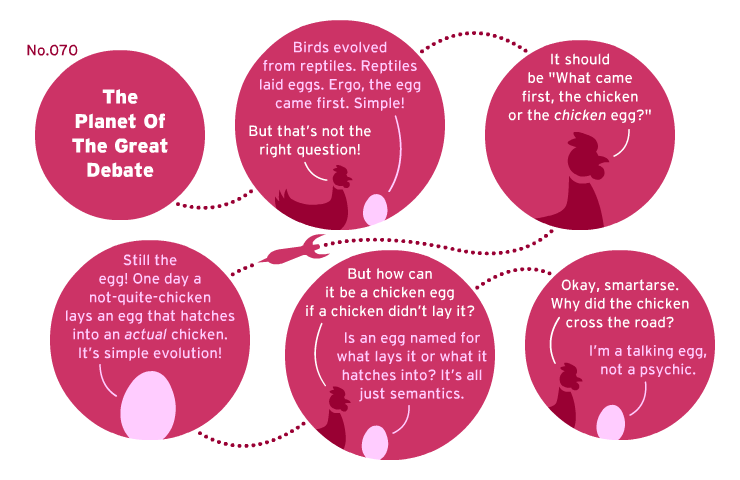
A psychic egg would be way cooler. Although also a lot quieter.

This is like an Onion parody on steroids. Only it’s 100 percent real.
Inspired by President Obama’s “Sputnik moment†speech back in January, the government-sponsored Smithsonian Institute has launched a new blog called “Department of Innovationâ€. As they describe it:
Seems a long time ago, but it was only back in January when Barack Obama told us that America had reached a “Sputnik moment.†He was referring to the competition with China to be the Big Dog of the 21st century global economy, but the subtext was that the country needs an attitude adjustment, that we need to start channeling Silicon Valley, a place where people may pledge to “Do no evil†but the true religion is innovation.
It made for one fine sound bite. But it hasn’t exactly inspired a bunch of innovation rallies and bake sales. So in the spirit of banging the drum for new ideas and fresh thinking, this blog will track all things innovative, not just in science and technology, but also in how we live, how we learn, how we entertain ourselves.
Sharp-eyed reader Rob M. certainly found the “Department of Innovationâ€s logo entertaining. You will, too.
Take a closer look:

As Rob wrote me this morning: “Check out the logo. 3 interlocking gears arranged in this fashion will not move in any direction. They are essentially locked in place. Which when you think about it, is a perfect analogy of today’s government!â€
Also a perfect analogy for a hapless administration’s pretense of entrepreneurial expertise: Total non-starter.
And that, my friends, is your government logo fail of the day…
***
Another commenter at the Smithsonian blog also noticed: “I love this feature. I thought, however, that I would comment on the Department of Innovation meshing gears logo. The gears can’t turn. Perhaps that was the intended effect?â€
Yeah, that’s the ticket.
Our commenter Cynosura adds: “Not to pick at nits, but the position of the gears (interlocking, thus unable to turn) is not the only problem with the logo. The gear pitch (space between tooth centers) is not consistent. I realize that it’s a logo and not a technical drawing, but it hurts my eyes to look at it. Even if the small gears were separated, the gears would likely jam during the first revolution…â€
Snortalicious!
World Wide Web turns 20, finally shakes that acne problem originally appeared on Engadget on Sat, 06 Aug 2011 11:53:00 EDT. Please see our terms for use of feeds.
Permalink  |Â Slate  | Email this | Comments
Slate  | Email this | Comments 



























Spool is recounting the story of an unnamed large ecommerce retailer who had one of those forms that made you register before you could buy anything, and to remember your login and password before you could shop there again. Removing this form, and allowing the option of saving your details with a login and password at the end of the transaction, increased the retailer's sales by $300,000,000 in the first year.
From a commerce perspective, the Internet's glory is reduced search costs for customers. When I was making my office coffee table, I decided I wanted to source some brightly colored anodized aluminum bolts, nuts and washers. I'd never bought these before, but I assumed they existed, and I was right -- a couple searches showed me that they existed and were sold to motorcycle modders. I found a site that supplied them, and ordered sixteen of each, plus some spares. It was the first time in 39-some years I'd needed brightly colored bolts, and it may very well be that long again before I need any more.
So while this specialist bolt retailer is visible to motorcyle hobbyists and can compete for their repeat business with other specialists, they're also tapping into a market to whom they were entirely invisible until the net came along. Periodically, someone like me is going to drop in and spend some money on a one-off basis, and make windfall cash for them. There are a lot of people who, at some time in their lives, want to buy some specialized component or good. Before the Internet came along, we'd likely have just got the non-specialized equivalent. But because of the Internet, businesses all over the world are getting sales from the unlikeliest of corners. And what's more, some of those one-time only customers might discover that they actually really enjoy whatever the specialist thing is, and come back for more. It's win-win.
But the fastest way to alienate those customers and scare away that free money is to make its owner establish a relationship with you before s/he can make a purchase. In the case of the company that sold me my bolts, I was required to create a login and password, and I still get a fortnightly newsletter full of information I don't care to know about bolts (I checked all the opt-out bits, but either I missed one or they just don't pay attention to it).
Spool's research showed that a substantial portion of ecommerce users are even more sick of this stuff than I am -- $300 million/year's worth, in fact. And what's more, of the repeat customers who might have benefited from the faster checkout afforded by creating an account, 45 percent had multiple accounts in the system because they'd forgotten their logins, lost access to the email accounts they'd used, and signed up again with a new address.
Repeat customers weren't any happier. Except for a very few who remembered their login information, most stumbled on the form. They couldn't remember the email address or password they used. Remembering which email address they registered with was problematic - many had multiple email addresses or had changed them over the years.The $300 Million Button (via Beth Pratt)When a shopper couldn't remember the email address and password, they'd attempt at guessing what it could be multiple times. These guesses rarely succeeded. Some would eventually ask the site to send the password to their email address, which is a problem if you can't remember which email address you initially registered with.
(Later, we did an analysis of the retailer's database, only to discover 45% of all customers had multiple registrations in the system, some as many as 10. We also analyzed how many people requested passwords, to find out it reached about 160,000 per day. 75% of these people never tried to complete the purchase once requested.)
The form, intended to make shopping easier, turned out to only help a small percentage of the customers who encountered it. (Even many of those customers weren't helped, since it took just as much effort to update any incorrect information, such as changed addresses or new credit cards.) Instead, the form just prevented sales - a lot of sales.
 In a partnership with the University of Phoenix the Institute for the Future has produced a new report titled Future Work Skills 2020. You may be weary of the University of Phoenix, but I can vouch for the IFTF. However, I have mixed feelings about the report. It identifies the key driving factors changing the workplace, but the actual skills section leaves something to be desired.
In a partnership with the University of Phoenix the Institute for the Future has produced a new report titled Future Work Skills 2020. You may be weary of the University of Phoenix, but I can vouch for the IFTF. However, I have mixed feelings about the report. It identifies the key driving factors changing the workplace, but the actual skills section leaves something to be desired.
This report is probably best for college students or mid-career workers thinking about making a change but haven't looked deeply into the matter yet.
Six drivers of change:
Some of these are more obvious than others, and futurists have been talking about most of these issues for decades now. However, they are indeed some of the most important drivers of the workplace and both students and workers should be be thinking about how these trends will effect them.
I'm more disappointed with the skills the report highlights. As a result of these drivers, the report suggests the following as key skills in the future workforce:
Almost all of these map well to established workplace terms, such as:
Only that last one, virtual collaboration, seem genuinely new. However, I do think some of these skills, although not new, are becoming more important. In particularly the desire for people with multidisciplinary background, sometimes called "t-shaped," is increasing as technologies converge. For example, the job market is starting to demand programmers with design skills, designers with programming skills, IT operations staff with business knowledge and marketers with a strong knowledge of information technology skills. We also covered how data center workers need to train across disciplines thanks to virtualization and cloud technologies.
See also:our readers' take on what the workplace of the future will look like.
Discuss